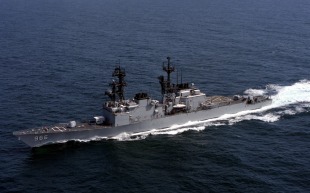Есмінець USS Hewitt (DD-966)
Основна інформація
Головні розміри
Машина
- 4 * General Electric LM2500 gas turbines
- 2 * shafts, 80,000 shp (60 MW)
Персонал
Бойові сили та засоби
- AN/SPS-40 air search radar
- AN/SPG-60 fire control radar
- AN/SPS-55 surface search radar
- AN/SPQ-9 gun fire control radar
- Mark 23 TAS automatic detection and tracking radar
- AN/SPS-65 Missile fire control radar
- AN/SQS-53 bow mounted Active sonar
- AN/SQR-19 TACTAS towed array Passive sonar
- Naval Tactical Data System
- AN/SLQ-32 Electronic Warfare System
- AN/SLQ-25 Nixie Torpedo Countermeasures
- Mark 36 SRBOC Decoy Launching System
- AN/SLQ-49 Inflatable Decoys
- 2 * 5 in (127 mm) 54 calibre Mark 45 dual purpose guns
- 2 * 20 mm Phalanx CIWS Mark 15 guns
- 1 * 8 cell ASROC launcher (removed)
- 1 * 8 cell NATO Sea Sparrow Mark 29 missile launcher
- 2 * quadruple Harpoon missile canisters
- 2 * Mark 32 triple 12.75 in (324 mm) torpedo tubes (Mk 46 torpedoes)
- 1 * 61 cell Mk 41 VLS launcher for Tomahawk missiles
- 2 * Sikorsky SH-60 Seahawk LAMPS III helicopters
USS Hewitt (DD-966), honoring Admiral H. Kent Hewitt USN (1887–1972), was a destroyer of the Spruance class constructed by the Ingalls Shipbuilding Division of Litton Industries in Pascagoula, Mississippi. Launched on 14 September 1974 by Mrs. Leroy Hewitt Taylor and Mrs. Gerald Hewitt Norton, daughters of Admiral Hewitt, it entered service on 25 September 1976. Hewitt initially trained and then headed to the Western Pacific in September 1978, operating within the U.S. 7th Fleet.
Beyond its primary role, Hewitt functioned as a diplomatic representative during visits to Australia, New Zealand, Fiji, and Hong Kong. It returned to San Diego in April 1979, engaging in a multinational Rim-of-the-Pacific (RIMPAC) battle group exercise in February and March 1980 to prepare for its subsequent deployment.
During its voyages, Hewitt displayed the U.S.'s commitment to safeguarding access to Middle East petroleum resources and aiding in the release of American hostages in Iran. The ship earned accolades such as the Navy Expeditionary Medal and the Humanitarian Service Medal. Hewitt underwent extensive enhancements in 1981, focusing on survivability and swift response to missile threats.
Departing for its third deployment in March 1983, Hewitt participated in various exercises, including fleet operations with aircraft carriers in the South China Sea. Further deployments followed, marked by notable achievements, including record-setting performances in naval exercises and commendations for its services in the Persian Gulf.
Notably, during its time in Yokosuka, Japan, Hewitt engaged with a multitude of international forces and played a vital role in operations like Maritime Interception Force (MIF) during Operation Desert Storm in 1991.
Over the years, Hewitt underwent modernization, receiving advanced systems like the Vertical Launch System and the Tomahawk Missile System. Its deployments continued to involve significant contributions to peacekeeping efforts and various naval exercises.
Ultimately, Hewitt concluded its service in July 2001, being decommissioned and sold for scrap. Its legacy remained marked by numerous accolades and a rich history of service across multiple theaters of operation.
- Коментарі
 uk
uk en
en ru
ru




 Військово-Морські Сили США
Військово-Морські Сили США Ingalls Shipbuilding
Ingalls Shipbuilding